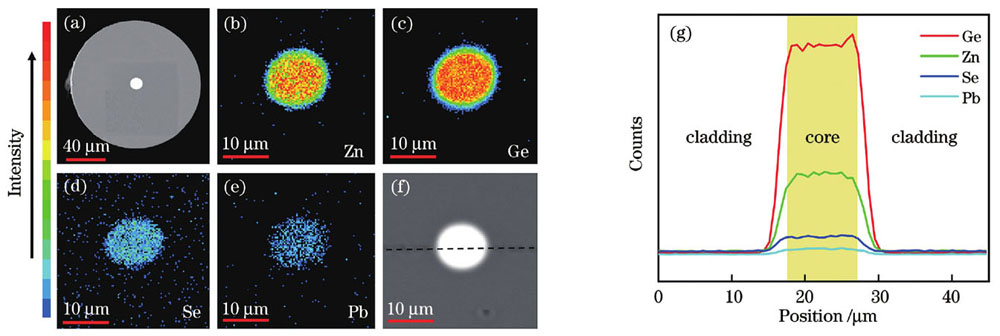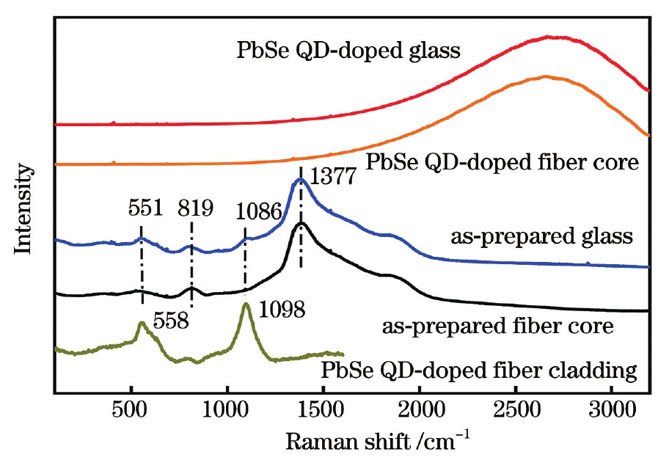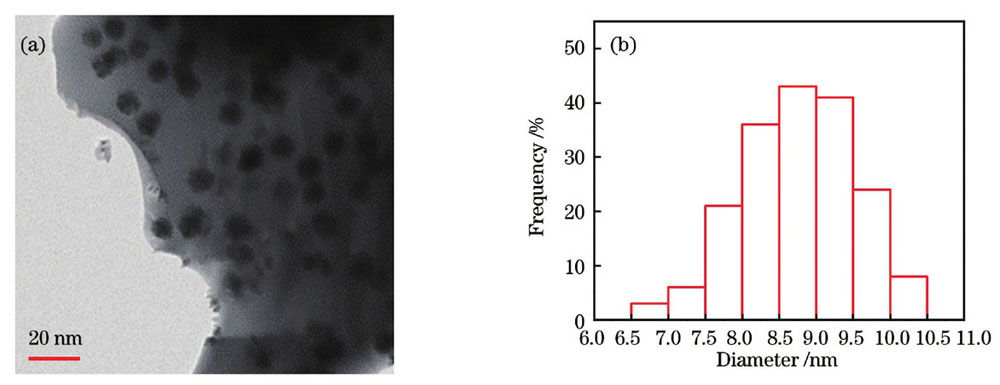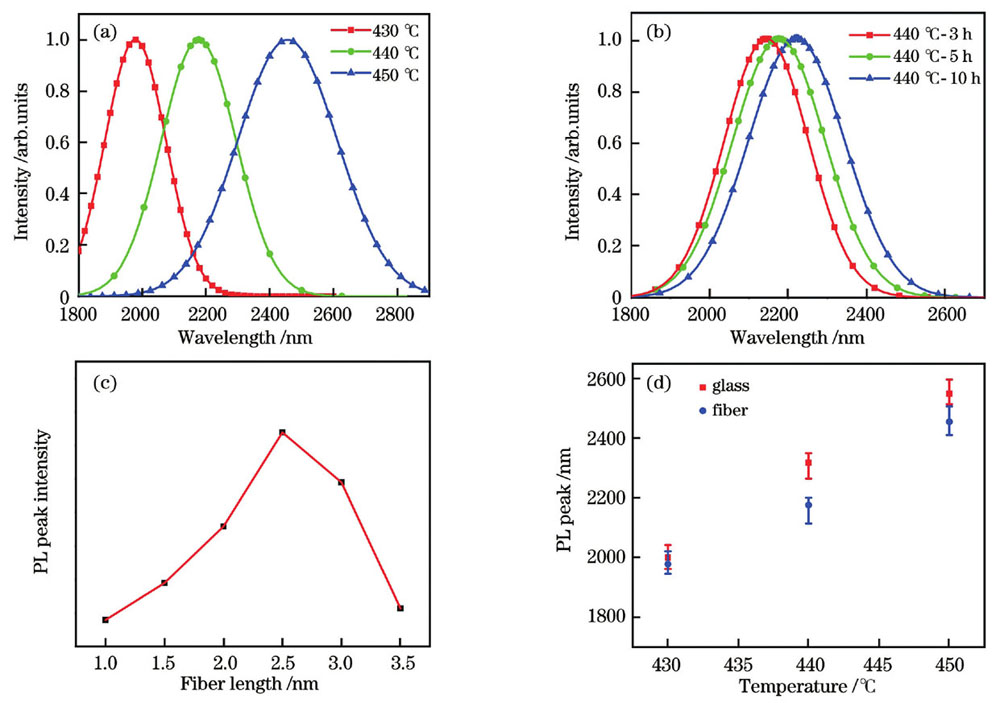中红外宽带荧光PbSe量子点掺杂玻璃光纤研究  下载: 1097次
下载: 1097次
宽带可调谐中红外光源在光谱传感器以及医疗、环境监测等实际应用方面备受关注。目前,发光玻璃主要通过稀土离子掺杂来实现中红外波段发光,但其可调范围较小。PbSe量子点具有较窄的带隙、较大的玻尔半径,因而易实现量子限域效应。在低声子能量的锗酸盐玻璃中原位析出PbSe量子点,有望产生近中红外宽带可调谐荧光发射。本课题组利用管内熔融法成功制备了全固态PbSe量子点掺杂玻璃光纤,获得了覆盖1.8~2.8 μm的宽带可调谐发射,有望用于宽带可调谐中红外光源。
Broadband tunable mid-infrared (MIR) light sources have attracted much attention in practical applications such as spectral sensors, medical treatment, and environmental monitoring. At present, MIR emission from luminescent glass is primarily achieved through rare-earth ion doping. Its adjustable range, however, is relatively limited. As PbSe quantum dots (QDs) have a narrow band gap and a large Bohr radius, they are easily capable of achieving quantum confinement effect. PbSe QDs formed in germanate glass with low phonon energy can produce broadband tunable MIR emission spanning the wavelength range of 1.82.8 μm. Using the melting-in-tube fiber drawing method, we successfully prepared all-solid-state PbSe QD-doped glass fiber and obtained broadband tunable emission covering 1.82.8 μm. Therefore, PbSe QD-doped glass fiber is expected to be used for broadband tunable MIR light sources.
PbSe QD-doped germanate glass was prepared using the melting-quenching method and was selected as the core glass of glass fiber. The core glass and cladding glass were prepared into an optical fiber preform by cold working, which included rounding, perforating, polishing, and cleaning. Following that, the optical fiber preform was suspended in a resistance furnace and drawn into an optical fiber using the melting-in-tube method. The softening temperature of the cladding glass was 840 ℃, according to the DSC curve. The PbSe QD-doped glass fiber was successfully drawn at 1000 ℃ after several attempts at various temperatures. At a heating rate of 6 ℃ min-1, the resistance furnace was heated to 1000 ℃. The cladding glass tube was then softened and the core glass was molten at this point. The precursor fiber was then quickly drawn without crystallization. Finally, the precursor fiber was heat treated to induce controllable precipitation of PbSe QDs in the glass fiber.
PbSe QD-doped glass was prepared by the melting-quenching method. The XRD spectra in Fig. 2 proved that PbSe QDs were precipitated in the heat-treated glass. Under 808 nm laser excitation, PbSe QD-doped glass could achieve broad MIR emission covering 1.82.8 μm [Fig.3(b)]. The melt-in-tube melting was used to successfully fabricate PbSe QD-doped glass fiber without crystallization. We observed from the EPMA test in Fig. 4 that the optical fiber had a good core-cladding structure with no obvious elemental migration between the fiber core and cladding. TEM was used to examine the distribution and size of QDs in a heat-treated fiber at 440 ℃. PbSe QD-glass fibers under different heat treatment schedules exhibited intense tunable MIR emission covering 1.82.8 μm when excited using an 808 nm laser (Fig. 7). Different heat treatments can be used to adjust the position of the emission peak. Finally, the PbSe QD-doped glass fiber had an optical loss of 17.19 dBm/m (Fig.8).
This study presented the preparation and characterization of an all-solid-state PbSe QD-doped glass fiber with tunable broadband MIR emission. Based on the selection and optimization of the basic glass system, a size-controllable PbSe QD-doped glass was prepared and achieved broadband tunable emission in the MIR regions of 1.82.8 μm. The core glass was a PbSe QD-doped borosilicate glass, and the cladding glass was a PbSe QD-doped borosilicate glass. The PbSe QD-doped glass fiber was successfully prepared using the melt-in-tube melting, and it was then characterized using EPMA. There was no evidence of elemental migration in the glass fibers, which had a complete core-cladding structure. When excited by an 808 nm laser, PbSe QD-doped glass fibers produced broadband tunable emission within 1.82.8 μm, which was expected to be used as a broadband tunable MIR light source.
1 引言
中红外波段的光纤激光器在高精度生物组织处理、气体分析和传感等领域具有广阔的应用前景[1-5],引起了众多科研工作者的兴趣,尤其是宽带可调谐中红外光源,其在诸多实际应用方面备受关注[6-9]。Pb基硫属族量子点(PbS、PbSe、PbTe)具有较窄的带隙和较大的玻尔半径,因而具有较强的量子限域效应,能够提供荧光峰位可调谐的红外荧光发射。PbSe量子点的激子玻尔半径为23 nm,禁带宽度为0.28 eV,较易实现中红外发光[10]。目前,PbSe量子点可在不同玻璃基质中通过热诱导方法原位形成,实现可调谐近中红外荧光发射。Wang等[11]在硅酸盐玻璃中通过热处理诱导析出了PbSe量子点,其荧光发射范围可覆盖1104~2185 nm;Kolobkova等[12]制备了高掺杂浓度的PbSe量子点掺杂氟磷酸盐玻璃,其量子效率在1~1.7 μm光谱范围内可达到50%。然而,这些玻璃基质在中红外波段的透过率较低,而且硒元素在这些玻璃基质中的溶解度较低,因此,PbSe量子点的荧光发射被限于近红外波段。Wang等[13]探究了不同锗硅比例的锗硅酸盐玻璃中PbSe量子点的形成和生长情况,并实现了PbSe量子点在中红外波段(小于2.6 μm)的光致发光。这是因为氧化锗是良好的玻璃形成体,相对于氧化硅来说可以降低玻璃的熔融温度,有效减少硫属元素的挥发,保持玻璃中量子点的浓度,易形成较大尺寸的PbSe量子点;同时,锗酸盐玻璃相比于硅酸盐玻璃具有更高的中红外透过率,是中红外荧光发射的优良基质材料。
所查资料显示,目前对于PbSe量子点光纤的研究还比较少。Zhang等[14]从荧光寿命、吸收发射截面、斯托克斯位移和半峰全宽入手,模拟了PbSe量子点光纤的发射特性,为实验探究提供了理论指导。Cheng等[15]以紫外凝胶为纤芯材料,制备了长度和掺杂浓度不同的PbSe量子点掺杂光纤,首次通过实验证明了PbSe量子点掺杂光纤放大器的可行性。但液芯光纤的光稳定性较差,考虑到器件的使用性能,仍需探索更接近实际应用的全固态PbSe量子点掺杂玻璃光纤。近年来,本课题组利用管内熔融法制备了析晶可控的全固态CdS量子点和PbS量子点掺杂玻璃光纤,实现了可见和近红外波段的可调谐发光[16-18]。因此,利用管内熔融法有望实现全固态PbSe量子点掺杂玻璃光纤的研制。
本课题组利用管内熔融法成功制备了全固态PbSe量子点掺杂锗硅酸盐玻璃光纤,分析了量子点光纤的微观结构以及光纤中量子点的形貌和分布,并探测到了覆盖1.8~2.8 μm的宽带可调中红外荧光发射。所制备的全固态PbSe量子点掺杂锗硅酸盐玻璃光纤表现出了优异的光学性能,有望在宽带可调谐中红外光纤激光器领域得到应用。
2 实验
2.1 玻璃的制备
利用熔融淬冷法制备了组分为30SiO2-22GeO2-10ZnO-28Na2O-10BaO-0.6PbO-1.2ZnSe(物质的量分数,%)的光纤芯层玻璃,使用的原料为SiO2(纯度为99.9%)、GeO2(纯度为99.999%)、ZnO(纯度为99.9%)、Na2CO3(纯度为99.99%)、BaCO3(纯度为99.99%)、PbO(纯度为99.99%)和ZnSe(纯度为99.99%),其中的PbO和ZnSe为PbSe量子点的引入源。将150 g玻璃生料在玛瑙研钵中充分研磨后转移到带盖的刚玉坩埚中,并在1050 ℃高温井式炉中烧制1 h。保温过程中利用石英搅拌杆对玻璃液进行搅拌,以加速熔融过程和提高玻璃的均匀性。将保温结束的熔融玻璃液迅速浇注到预热温度为200 ℃的黄铜模具中,淬冷形成玻璃,然后通过退火处理来释放玻璃中的内应力,即:将玻璃在350 ℃保温5 h后缓慢冷却至室温,缓冷时间为7 d。
将退火后的玻璃切割成数块1 cm×1 cm×0.1 cm的玻璃块,抛光后进行测试表征。将剩余的块状玻璃在车床上冷加工成直径约为3.0 mm、长度约为60 mm的圆柱棒,将玻璃棒表面进行抛光处理,然后利用无水乙醇进行超声清洗,制成光纤预制棒的芯层玻璃。包层玻璃管采用中国南通振华光电有限公司生产的K9硼硅酸盐玻璃管,其组成成分为73.29SiO2-10.09B2O3-1.25BaO-4.07K2O-11.3Na2O(物质的量分数,%)。该玻璃管的内径为3.1 mm,深度为50 mm,外径为30 mm,长度为80 mm。将芯层圆柱棒玻璃插入包层玻璃管中制成光纤预制棒。
2.2 光纤的拉制
将光纤预制棒悬挂在电阻炉中利用管内熔融法拉制成光纤。根据差示扫描量热仪(DSC)测得的包层玻璃的热分析曲线(DSC曲线),其软化温度为840 ℃。经过不同温度下的多次拉制尝试,最终在1000 ℃下成功拉制出了析晶可控的PbSe量子点掺杂玻璃光纤。以6 ℃/min的加热速率将电阻炉升温至1000 ℃,此时包层玻璃管软化,而芯层玻璃处于熔融状态,因此可迅速拉制成不析晶的前驱体玻璃光纤。最后,对前驱体玻璃光纤进行热处理,诱导PbSe量子点在光纤芯层中可控析出,得到PbSe量子点掺杂玻璃光纤。
2.3 分析测试
利用D8-Avance型X射线衍射仪对玻璃和光纤进行晶体分析;利用STA449C Jupiter同步热分析仪对玻璃的玻璃化转变温度(Tg)和软化温度(Ts)进行测试;采用JEM-2100F型透射电子显微镜(TEM)观察玻璃与光纤中晶体的形貌和分布;利用紫外/可见/红外分光光度计测试玻璃的吸收光谱;采用EPMA-1600型微区电子探针分析仪对光纤断面进行元素分布测试;玻璃和光纤的中红外荧光光谱测试采用Omni 5015i型光谱仪进行,采用808 nm激光泵浦。
3 结果分析与讨论

图 2. 前驱体玻璃以及在不同热处理温度下处理5 h的PbSe量子点掺杂玻璃的XRD图
Fig. 2. XRD patterns of as-prepared glass and PbSe quantum dot (QD)-doped glasses heat-treated at different temperatures for 5 h
由

图 3. 前驱体玻璃以及在不同温度下热处理5 h的PbSe量子点掺杂玻璃的吸收光谱和发射光谱。(a)吸收光谱;(b)在808 nm激光激发下的发射光谱
Fig. 3. Absorption and photoluminescence spectra of as-prepared glass and PbSe QD-doped glasses heat-treated at different temperatures for 5 h. (a) Absorption spectra; (b) photoluminescence (PL) spectra excited by 808 nm laser
PbSe量子点掺杂锗硅酸盐玻璃能够实现中红外发光,本课题组将其作为芯层玻璃,将K9硼硅酸盐玻璃作为包层玻璃,加工制成光纤预制棒,然后利用管内熔融法将其拉制成析晶可控的PbSe量子点掺杂玻璃光纤。在管内熔融法拉制光纤过程中,芯层玻璃处于熔融状态,包层玻璃处于软化状态,通过快速拉丝冷却可以避免芯层玻璃的不可控析晶,但可能会导致光纤芯层/包层玻璃出现元素扩散现象,致使光纤芯层/包层玻璃组分与原始玻璃组分出现偏差,严重时还会使量子点在后续热处理过程中于包层玻璃中析出。为了研究PbSe量子点掺杂光纤中各元素的分布情况,本课题组利用电子探针微区分析(EPMA)技术探究光纤端面的元素分布情况,结果如

图 4. PbSe量子点前驱体光纤横截面的背散射电子显微图和EPMA分析结果。(a)光纤端面的背散射电子显微图;(b)~(e)光纤端面上不同元素的EPMA面扫描图;(f)光纤的局部放大背散射电子显微图;(g)光纤沿图4 (f)中虚线 路径的EPMA线扫描图
Fig. 4. Back scattering images and EPMA analysis of PbSe QD-doped precursor fiber cross-section. (a)Back scattering image of fiber cross-section; (b)(e) EPMA images of different elements in PbSe QD-doped precursor fiber cross-section; (f) partially enlarged back scattering image of fiber cross-section; (g) EPMA line scanning curves of fiber along dotted path in Fig.4(f)
为了探究PbSe量子点掺杂玻璃和光纤中的析晶情况,本课题组采用拉曼光谱仪对玻璃和光纤进行分析。从

图 5. 前驱体玻璃与光纤芯层以及热处理后的PbSe量子点掺杂玻璃与光纤芯层、包层的拉曼光谱
Fig. 5. Raman spectra of as-prepared glass and precursor fiber cores, heat-treated PbSe QD-doped glass, and PbSe QD-doped glass fiber core and cladding
为了探究PbSe量子点掺杂玻璃光纤中PbSe量子点的形貌和尺寸,本课题组将440 ℃热处理后的光纤研磨成粉,放到透射电子显微镜(TEM)下进行观察,结果如

图 6. 热处理后PbSe量子点掺杂玻璃光纤的TEM图及光纤中量子点的尺寸分布。(a)TEM图;(b)光纤中PbSe量子点的尺寸分布
Fig. 6. TEM image and size distribution of PbSe QD-doped glass fiber after heat treatment. (a) TEM image; (b) size distribution of PbSe QDs in glass fiber

图 7. 808 nm激光激发下,PbSe量子点掺杂玻璃光纤的荧光光谱。(a)PbSe量子点掺杂玻璃光纤在不同温度下热处理5 h后的荧光光谱;(b)PbSe量子点光纤在440 ℃热处理不同时间后的荧光光谱;(c)在440 ℃热处理的PbSe量子点玻璃 光纤的荧光强度随光纤长度的变化;(d)不同批次PbSe量子点掺杂玻璃和光纤在不同温度热处理后的荧光光谱
Fig. 7. PL spectra of PbSe QD-doped fiber excited by 808 nm laser. (a) PL spectra of PbSe QD-doped fiber heat-treated at different temperatures for 5 h; (b) PL spectra of fiber heat-treated at 440 ℃ for different durations; (c) variation of PL peak intensity of PbSe QD-doped glass fibers heat-treated at 440 ℃ with fiber length; (d) PL spectra of different batches of PbSe QD-doped glass and optical fibers heat-treated at different temperatures
本课题组利用截断法对PbSe量子点前驱体光纤以及在440 ℃热处理后的光纤进行光纤损耗测试来表征光传输性能。如

图 8. 利用截断法测试获得的PbSe量子点前驱体光纤和热处理光纤在1530 nm处的光损耗
Fig. 8. Optical loss of as-prepared and heat-treated PbSe QD-doped fiber at 1530 nm measured by cutback method
4 结论
本课题组成功制备了全固态PbSe量子点掺杂玻璃光纤,并实现了中红外可调谐宽带荧光发射。基于对基础玻璃体系的选择和优化,本课题组制备了量子点尺寸可控的PbSe量子点掺杂玻璃,获得了1.8~2.8 μm中红外波段宽带可调谐发光;将PbSe量子点玻璃作为芯层,选择热学性能较为匹配的硼硅酸盐玻璃作为包层,利用管内熔融法成功拉制了PbSe量子点掺杂玻璃光纤。通过EPMA表征发现,拉制的PbSe量子点掺杂玻璃光纤具有完整的芯包结构,波导结构完整。通过拉曼光谱和TEM证明了光纤中成功析出了PbSe量子点。在808 nm激光激发下,PbSe量子点掺杂玻璃光纤获得了1.8~2.8 μm的宽带可调谐发光。可见,所制备的PbSe量子点掺杂玻璃光纤有望应用于宽带可调谐中红外光源。
[1] Rodrigo D, Limaj O, Janner D, et al. Mid-infrared plasmonic biosensing with graphene[J]. Science, 2015, 349(6244): 165-168.
[2] Huang F F, Liu X Q, Ma Y Y, et al. Origin of near to middle infrared luminescence and energy transfer process of Er3+/Yb3+co-doped fluorotellurite glasses under different excitations[J]. Scientific Reports, 2015, 5: 8233.
[3] Hugi A, Villares G, Blaser S, et al. Mid-infrared frequency comb based on a quantum cascade laser[J]. Nature, 2012, 492(7428): 229-233.
[5] 郭春雨, 董繁龙, 沈鹏生, 等. 20 W中红外2.8 μm全光纤激光器研究[J]. 中国激光, 2021, 48(14): 1416001.
[8] Petersen C R, Møller U, Kubat I, et al. Mid-infrared supercontinuum covering the 1.413.3 μm molecular fingerprint region using ultra-high NA chalcogenide step-index fibre[J]. Nature Photonics, 2014, 8(11): 830-834.
[9] Zhao Z M, Wu B, Wang X S, et al. Mid-infrared supercontinuum covering 2.016 μm in a low-loss telluride single-mode fiber[J]. Laser & Photonics Reviews, 2017, 11(2): 1770023.
[10] Wise F W. Lead salt quantum dots: the limit of strong quantum confinement[J]. Accounts of Chemical Research, 2000, 33(11): 773-780.
[11] Wang J, Zhang W, Liu C, et al. Growth of lead selenide quantum dots in silicate glasses[J]. Journal of Non-Crystalline Solids, 2017, 475: 44-47.
[12] Kolobkova E, Lipatova Z, Abdrshin A, et al. Luminescent properties of fluorine phosphate glasses doped with PbSe and PbS quantum dots[J]. Optical Materials, 2017, 65: 124-128.
[13] Wang J, Zhang J H, Liu C, et al. Germanosilicate glasses containing PbSe quantum dots for mid-infrared luminescence[J]. Journal of Non-Crystalline Solids, 2016, 431: 79-82.
[14] Zhang L, Huang T H, Ning L N, et al. Effects of doped material properties on the emission of quantum dot optical fiber[J]. Optical Fiber Technology, 2020, 58: 102305.
[15] Cheng C, Hu N S, Cheng X Y. Experimental realization of a PbSe quantum dot doped fiber amplifier with ultra-bandwidth characteristic[J]. Optics Communications, 2017, 382: 470-476.
[16] Huang X J, Fang Z J, Peng Z X, et al. Formation, element-migration and broadband luminescence in quantum dot-doped glass fibers[J]. Optics Express, 2017, 25(17): 19691-19700.
[17] Peng Z X, Huang X J, Ma Z J, et al. Surface modification and fabrication of white-light-emitting Tm3+/CdS quantum dots co-doped glass fibers[J]. Journal of the American Ceramic Society, 2019, 102(10): 5818-5827.
[18] Huang X J, Fang Z J, Kang S L, et al. Controllable fabrication of novel all solid-state PbS quantum dot-doped glass fibers with tunable broadband near-infrared emission[J]. Journal of Materials Chemistry C, 2017, 5(31): 7927-7934.
[19] Narendrudu T, Suresh S, Ram G C, et al. Spectroscopic and structural properties of Cr3+ ions in lead niobium germanosilicate glasses[J]. Journal of Luminescence, 2017, 183: 17-25.
[20] Korobatova N M, Shtenberg M V, Koroleva O N. The structure of glasses of the K2O-SiO2-GeO2 system based on Raman and IR spectroscopy data[J]. Glass Physics and Chemistry, 2020, 46(3): 228-233.
王伟, 古权, 陈钦鹏, 尹博钊, 李国振, 万芒, 黄雄健, 董国平. 中红外宽带荧光PbSe量子点掺杂玻璃光纤研究[J]. 中国激光, 2022, 49(1): 0101013. Wei Wang, Quan Gu, Qinpeng Chen, Bozhao Yin, Guozhen Li, Mang Wan, Xiongjian Huang, Guoping Dong. Investigation of PbSe Quantum Dot-Doped Glass Fibers with Broadband Mid-Infrared Emission[J]. Chinese Journal of Lasers, 2022, 49(1): 0101013.








